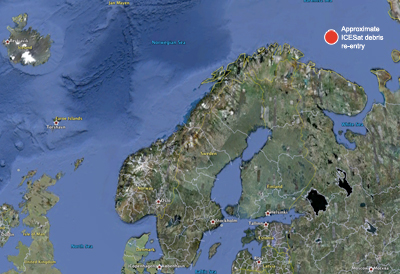
University of Colorado at Boulder (CU) Laboratory for Atmospheric and Space Physics (LASP) professionals and students have completed their role operating the NASA ICESat mission, one of five missions operated at LASP. ICESat reached the end of its productive seven-year life in June, when NASA began decommissioning the satellite because of instrument failure. The remaining spacecraft debris fell to Earth in the Barents Sea at 5 a.m. EDT on Aug. 30.
Bill Possel, LASP Mission Operations and Data Systems Director, said, “CU undergraduates have controlled ICESat for the past seven years from our Mission Operations Center here at LASP. Although we are sad to see such a successful science mission come to an end, we are proud of our students’ role in bringing the spacecraft safely out of orbit.”
LASP is one of only a handful of institutes in the world that give undergraduates the training and certification to operate NASA spacecraft. The opportunity to assist with decommissioning a spacecraft is even more rare. The last time a NASA science satellite re-entered Earth’s atmosphere was in January 2002, when the Extreme Ultraviolet Explorer re-entered the Earth’s atmosphere under conditions similar to ICESat. That satellite decommission was handled by NASA professionals.

Darren Osborne, LASP Flight Director for ICESat, said, “Our students had specific procedures to follow during the ICESat decommission. They ran calculations to determine where the spacecraft was located and made predictions for the NASA ground stations that tracked it. The students did this seven days a week until the decommission was complete.”
Using undergraduate students for spacecraft operations, although rare, offers a number of benefits. Possel said, “Student operators provide a lower cost to NASA, and CU students at LASP receive hands-on training and experience that helps position them for a future in space-related careers.”
ICESat has been important at CU not only because of the student role in operating the spacecraft, but because of the data that reside here. Data from ICESat’s Geoscience Laser Altimeter System (GLAS) instrument are archived at the National Snow and Ice Data Center (NSIDC) at CU. Although the mission is now over, NSIDC will continue to maintain the GLAS data archive and serve data and information to researchers who use the archived data in key research on elevation changes in Earth’s snow and ice. NSIDC is also the designated data archive for Operation IceBridge, a NASA airborne remote sensing mission that will fill the gap between the decommissioned ICESat mission and ICESat II, scheduled for launch in 2015.
The ICESat spacecraft was built by Ball Aerospace & Technologies Corp, also located in Boulder, Colorado.
More information
To learn more about the decommissioning of ICESat: http://icesat.gsfc.nasa.gov/icesat/index.php
To view NASA PR on ICESat re-entry: http://www.nasa.gov/mission_pages/icesat/icesat-end.html
To learn more about LASP Mission Operations: https://lasp.colorado.edu/mission-ops-data/
To learn more about students at LASP: https://lasp.colorado.edu/about/cu-students-at-lasp/
About the spacecraft: http://www.ballaerospace.com/page.jsp?page=188



